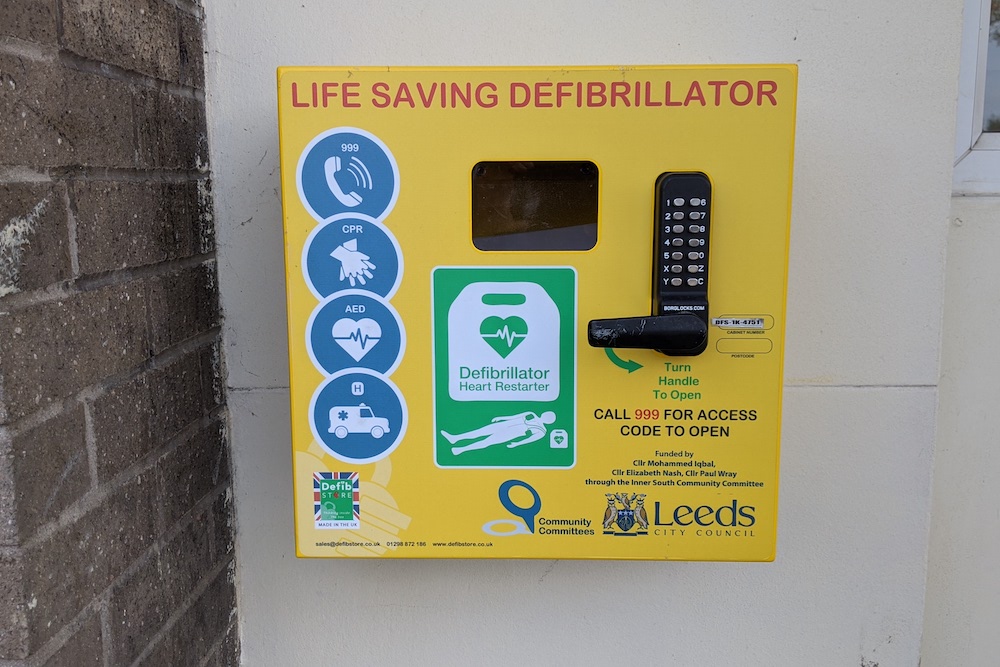
The sight of Christian Eriksen collapsing during the European football tournament brought home to many the fact that anyone can suffer a cardiac arrest.
A cardiac arrest means that your heart has stopped beating. It has stopped pumping blood around your body and delivering oxygen to your muscles and your brain. You are dying. Helping someone in cardiac arrest, whilst you wait for the ambulance to arrive, can save their life (see below).
Over the last two years more than twenty community public access defibrillators have been installed across South Leeds by Leeds City Council. Eight were funded from a citywide public health programme, with the remainder paid for by the Inner South Community Committee. You can find the locations on this interactive map, they are also listed below.
On top of these community public access defibrillators, other organisations, businesses and sports clubs, have their own defibrillators. Cross Flatts parkrun had invested in one, but it wasn’t publicly available 24/7 until Councillors stepped in to fund a secure external cabinet at the Watsonian Pavilion in the park.
Councillor Angela Gabriel (Chair of the Inner South Community Committee) said:
“Publically accessible defibrillators really can mean the difference between life and death and so I am very pleased that anyone who is unfortunate enough to need one in Cross Flatts Park will now be able to be given the assistance they need.”
Mark Hodgkinson (Cross Flatts parkrun Event Director) said:
“Cross Flatts parkrun and Junior parkrun are delighted that our event defibrillator is being made available for use outside of our event times. We hope that the defibrillator will never need to be used but very pleased that, if a defibrillator is needed by someone in Cross Flatts Park, one is now accessible.”
As we reported last December, the defibrillator at The Hunslet Club has already been used to save a life when it was borrowed by a local business. Club CEO Dennis Robbins commented:
“We were happy to part of this amazing scheme funded by our Ward Councillors, we didn’t expect the machine to be used so quickly, but we are proud that the defibrillator was at our site and helped another organisation and person in need.”
Using a Public Access Defibrillator is very straightforward, they have audio instructions and will not let you cause harm to the patient. To access the defibrillator call 999 and they will tell you the access code to unlock the cabinet.
Saving someone’s life Q&A
What is a defibrillator?
A defibrillator is a device that gives a high energy electric shock to the heart of someone who is in cardiac arrest. This high energy shock is called defibrillation, and it’s an essential part in trying to save the life of someone who’s in cardiac arrest. A defibrillator may also be referred to as a defib, an AED (Automated External Defibrillator) or a PAD (Public Access Defibrillator).
How do I know if someone is in cardiac arrest?
Someone having a cardiac arrest will either not be breathing or they won’t be breathing normally. They also won’t be conscious. Check for a response – gently shake the person’s shoulders and ask loudly ‘are you alright?’
What should I do if someone has a cardiac arrest?
Cardiac arrests can happen to anyone, at any time. The following steps give someone the best chance of survival. If you come across someone in cardiac arrest:
- Call 999
- Start CPR (cardiopulmonary resuscitation)
- Ask someone to bring a defibrillator if there’s one nearby (if no one is available to get one, listen to the emergency operator for further instructions)
- Turn on the defibrillator and follow its instructions
How do I get the defibrillator from the cabinet?
Ring 999, the operator will give you the code to the cabinet and stay on the line to help you use it.
Can I harm someone with a shock who doesn’t need it?
No. The machine will only give a shock once it has checked the heart needs one.
What is CPR? CPR, or cardiopulmonary resuscitation, is administering manual chest compressions to pump blood around the body. Look out for local training sessions. Find out more at from the British Heart Foundation at www.bhf.org.uk
Locations of public defibrillators across LS10 and LS11
- Holbeck Together, 99 Domestic Street, Holbeck, LS11 9NS
- Church of the Nazarene, 2 Hunslet Hall Road, Beeston, LS11 6TT
- The Hunslet Club, Hillage Road, Hunslet, LS10 1BP
- h2010 apartments, Cable Place, Hunslet, LS10 1GB
- Church of the Nazarene, Lupton Street, Hunslet, LS10 2QR
- Woodhouse Hill Community Centre, Woodhouse Hill Road, Hunslet Carr, LS10 2EF
- Greedy Monkeys Cafe, 3 Belle Isle Parade, LS10 3AH
- Belle Isle Working Men’s Club, Belle Isle Road, LS10 3PE
- St George’s Centre, St George’s Road, Middleton, LS10 4TQ
- St Cross Church, Middleton Park Avenue, LS10 4HT
- Sainsbury’s Local, 7 Middleton Park Avenue, LS10 4HP
- Hunslet Nelson Cricket Club, Gipsy Lane, Beeston, LS11 5TT
- Cottingley Community Centre, 115 Cottingley Approach, LS11 0HJ
- St Andrew’s Methodist Church, 10 Cardinal Road, Beeston, LS11 8AL
- Beeston Community Hub & Library, Town Street, Beeston, LS11 8PN
- Watsonian Pavilion, Cross Flatts Park, Beeston, LS11 7NA
- Hamara Healthy Living Centre, Tempest Road, Beeston, LS11 6RD
- KMWA Community Centre, Hardy Street, Beeston, LS11 6BJ
- Rowland Road Working Men’s Club, Rowland Road, Beeston, LS11 6ED
- Guru Nanak Gudwara (Sikh Temple), 78 Lady Pit Lane, Beeston, LS11 6DP
- Al Medina Mosque / Bangladeshi Centre, Rawson Terrace, Beeston, LS11 5JN
- Leeds City College Joseph Priestley Centre, Burton Avenue, Beeston, LS11 5ER


